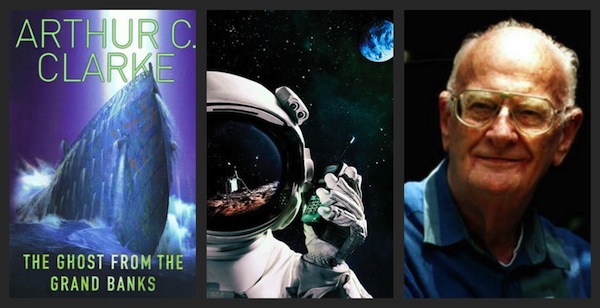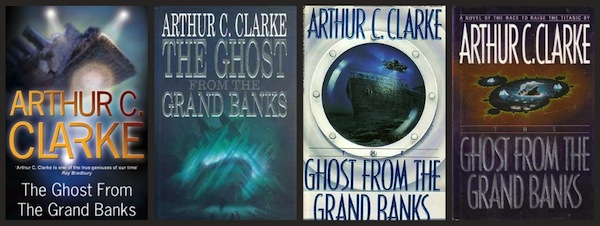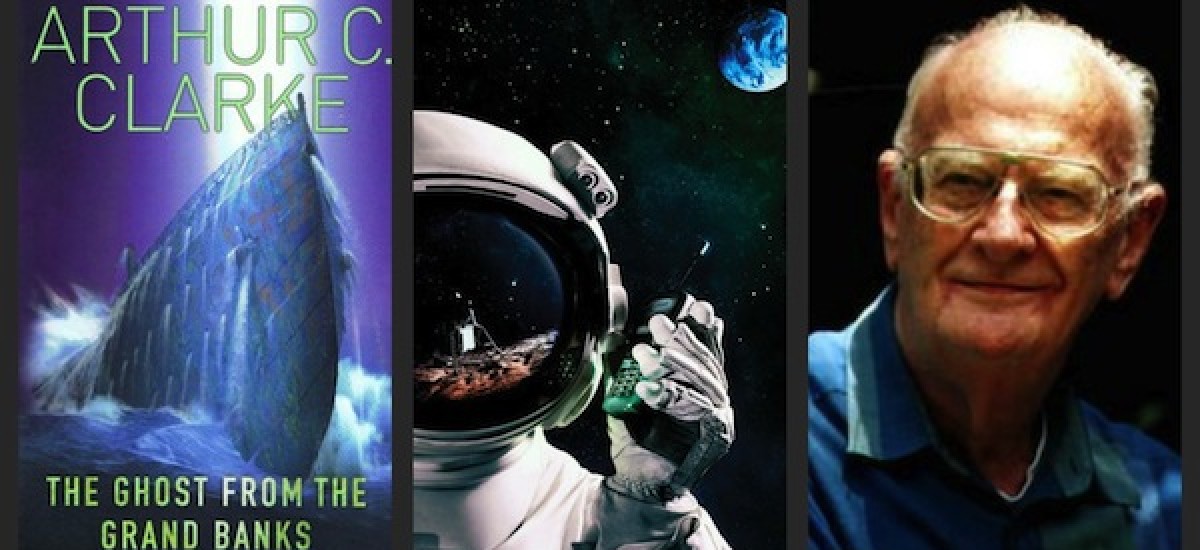
The year was 1989. Margaret Thatcher and George Bush, Snr., were in office. Mikhail Gorbachev was slowly but surely dismantling the Soviet Union. The infamous Iron Curtain was crumbling under pressure from ‘people power’ across Eastern Europe.
On the technology front, Personal Computers (PCs) had entered the market only a few years earlier: they were still gadgets in offices than homes. Mobile (cellular) phone services were just rolling out. The Internet was available only to privileged academics and military personnel. Its graphical interface – the World Wide Web – was not even invented.
In that year, sitting at his home in Colombo, Sri Lanka and using WordStar software on his Kaypro 2000 laptop (remember them, anyone?), Arthur C Clarke wrote a new science fiction novel. It was his own way of exorcising something that had haunted him for decades: the mighty ship Titanic.
As he reflected many years later, “I was born five years after the biggest maritime disaster the world had known: the sinking of the ‘unsinkable’ RMS Titanic while on her maiden voyage. My home town Minehead, in Somerset, was not more than a couple of hundred kilometres from Southampton, from where the Titanic set off. All my life, I have been intrigued by the Titanic disaster.”
The novel, published in late 1990 as The Ghost from the Grand Banks, was an ocean-based thriller set in the (then) near future. It revolved around rival British-American and Japanese teams trying to raise the legendary ship’s wreck in time for the centenary in 2012. Both teams mobilise mega-bucks and cutting edge technology: while one team relies on 50 billion little glass balls, the other’s ambitious plan involves making the world’s largest ice cube…
“It’s my first contemporary novel and is completely different from anything else. It begins in 1977 and goes up to 2012,” Clarke told a friend shortly after the manuscript was completed in early 1990.
When the book came out, it received mixed reviews. Although it had an exciting plot and interesting elements woven together, many reviewers found the characters to be weak – a common complaint about Clarke’s science fiction stories, especially his novels.
Kirkus Reviews, a leading American book review magazine, summed it up as follows: “Average Clarke, more emotional than usual, with excellent extrapolations of future technologies.”
In a more positive review, Gerald Jonas wrote in the New York Times: “He [Clarke] sees the universe as a marvellous toy, coquettishly begging to be understood yet always mocking our success with some deeper mystery…
The little lectures that he inserts to bring us painlessly up to speed on such matters are not digressions; his ability to keep a story moving ahead while teaching us what we must know to follow narrative logic wherever it leads is the very essence of his art. He only makes it look easy.”
A Pocketful of Asides
Nearly a quarter century after the book was written, those ‘little lectures’ and smart asides offer interesting glimpses into how Clarke’s mind worked. For decades, he was our amiable and playful “tour guide” to the future…
He has woven into the narrative a number of topics and ideas that he was deeply interested in at the time. These included fractal geometry of the Mandelbrot Set, campaigning against tobacco smoking, and the search for new energy sources to replace petroleum and coal.
Living as we do at the time when his story culminated, we can now compare his ‘extrapolations of the future’ – he carefully avoided labelling any of his ideas as ‘predictions’ – with what has become our reality.
On the information society front, at least, The Ghost from the Grand Banks stands up remarkably well in 2012. If we haven’t yet reached some heights of technological wizardry that Clarke imagined, that only leaves the geekdom with a few challenges to work on…
Clarke rightly anticipated the world of 2012 to be media-saturated, with governments and corporations deciding on key policies and actions with a careful eye on media relations (and fall-out). Call it the Age of Spin. Perhaps it’s an inevitable outcome of the chatty Global Family – created, in part, by the geostationary communication satellites that Clarke conceived in 1945.
In the Clarkian world of 2012, “Nippon-Turner Corporation” is the world’s largest media chain, reaching out to the whole world on multiple platforms and channels. Clarke used to tease CNN founder Ted Turner about deserving 10 per cent of the network’s profits. More seriously, he was intrigued by the ‘CNN Effect’ – the impact that CNN and other 24/7 global news channels on how states conduct their foreign policy.
Of course, at the time of writing, Japan was at the height of its property and stock market fuelled economic bubble. Clarke had no way of knowing how soon the bubble would burst, leading to a Lost Decade in which Japan would lose their leadership in many technologies and industries.
Curiously, a passing mention is made of a “celebrated media tycoon” (unnamed) who had placed his bet on the wrong system when high definition TV swept all before it at the end of the twentieth century. “Later attempts to restore his fortune also misfired, and he was now a guest of His Majesty’s Government for the next five years (assuming time off for good behaviour).”
Death of Geography
Throughout the pages of Ghost, almost like a sprinkling of pixie dust, we find insights into what ordinary life might be like in the early twenty first century – when access to information and communication is within reach of (almost) everyone, everywhere.
The divide between work and play has blurred for many of the 2.2 billion people regularly accessing the Internet today. It has also enabled new forms of real-time collaboration. Back in 1989, Clarke foresaw these trends being taken for granted by 2012.
For example, the Japanese-led attempt to raise the Titanic’s wreck involves working with some of America’s top engineers. Using encrypted (secure) communication networks, they work across many time zones. The internet is not mentioned by name, but Clarke’s vision of long-distance, multi-author collaborations is now commonplace.
Meanwhile, a billionaire inventor (Roy Emerson) is trying to keep himself usefully engaged now that he doesn’t have to work for a living. “Sometimes he would start on a project suggested by one of the countless network ‘magazines’, and join a group of similarly inclined hobbyists scattered all over the world. He seldom knew their names – only their often facetious call-signs – and he was careful not to give his. Since he had been listed as one of the hundred richest men in the United States, he had learned the value of anonymity.”
Clarke envisages Emerson becoming bored with some long-distance projects, and changing his ‘Ident Code’ completely so that he can exit the group without leaving a trace. He also “wastes time exploring Personal Notice Boards whose contents would have appalled the first pioneers of electronic communication”.
But “all play and no work was making Emerson a very dull Roy”. Luckily, a formidable challenge lands on his desk (electro-pad?) that saves him from terminal boredom: the British-American bid to raise the Titanic.
To better appreciate some of Clarke’s passing remarks, we have to remember tech trends as the 1980s decade drew to a close. Jason Bradley, the world’s leading oceanographer and underwater trouble-shooter, still uses a NeXT Mark 4. It is “hardly the last word in computers, but Bradley’s business had grown up with it, and he had resisted all updates, on the sound principle ‘If it works, don’t fix it’”.
In the real world, Steve Jobs – who launched NeXT Computers in 1988 after being forced out of Apple – discontinued that product line in 1990. Although NeXT was not a great commercial success, some machines are still used around the world as servers and hobbyist desktops.
Clarke describes another tech phenomenon that emerged in the first decade of the new millennium: Terabyte Interactive Microlibraries, or TIMs. These blocks of crystal, about the size of a matchbox, had made their way from Hong Kong via Cuba “had put so many US publishers out of business that Congress had dusted off legislation that dated back to the heyday of Prohibition”.
These sound much like today’s e-books, which have indeed shaken the traditional publishing industry and transformed the way many people read.
Beyond speculating on consumer tech trends, Clarke also touches on the communication infrastructure, the planet-wide wiring and ‘plumbing’ that enables our incessantly chattering planet.
An example is POLAR 1, the first fibre-optic cable to be laid under the Arctic icecap. Its benefit: “By eliminating the long haul up to the geostationary orbit, and its slight but annoying time-delay, the global phone system had been noticeably improved; speakers no longer kept interrupting each other, or wasting time waiting for replies.”
But Clarke is at his best when exploring the social, cultural and psychological impacts of technology. (He was happy to leave the complex engineering problems to the real geeks.)
For instance, he talks about the Rubik’s Cube making a comeback 30 years after its first appearance, and in a far more deadly mutation. A quick check on the official Rubik website, and a Google search, shows no such device has yet emerged. Perhaps that’s a fortune waiting to be made…

Ending a ‘Savage Century’
Despite all this and more, The Ghost from the Grand Banks isn’t just a potpourri of clever ideas held together by a motley collection of geeks and billionaires. The novel is, in fact, underpinned by a number of core themes.
Long-time Clarke fans will notice several recurrent ones, among them: studying and conserving the oceans as a global commons; finding alternatives for war to engage human aggression (competitive sport? space exploration?); and striking the right balance between technology, material progress and ethics.
Despite his well known enthusiasm for humanity’s technology-driven future, Clarke was well aware of its pitfalls and dangers. He once again uses a favourite phrase — ‘Artificial Stupidity’ — to caution about dangers of over-reliance on computers.
Clarke often acknowledged that economics and politics were his “blind spots” even if that didn’t stop him from imagining desirable near futures. He has written about the hazards of prophecy as it is impossible to predict near-term political developments with any degree of precision or certainty.
The Cold War had not quite ended when this novel was written (although the Berlin Wall came down during its creation). So Clarke was being cheeky – or whimsical — when he suggests nuclear-powered military submarines of the United States and the ‘land once more called Russia’ being commercially hired to fee-paying customers of 2012. (For Clarke’s perspectives on the far-reaching events of 1989-90, read How the World Was One: Beyond the Global Village, published in 1992.)
He can perhaps be forgiven for not anticipating the full turn of events that followed the Soviet Union’s collapse. Although they were already active in their own spheres of influence, both Vladimir Putin and Osama Bin Laden were still relatively unknown in 1989…
Clarke uses his cautious optimism to rekindle larger debates that are far from resolved, even today. For example, he imagines the editorial in the London Times of 15 April 2007 (“available in Hardcopy and NewsSat editions”) making a fervent plea for letting the Titanic “rest in peace” where it settled on the night of 15 April 1912.
It ends with these words: “There is no need to revisit her to be reminded of the most important lesson the Titanic can teach – the dangers of overconfidence, of technological hubris. Chernobyl, Challenger, Lagrange 3 and Experimental Fusor One have shown us where that can lead…”
He also briefly touches on a Big Question that he has regularly addressed for a long time, especially since he famously theorised the invention of tools by our ape ancestors in 2001: A Space Odyssey (1968): can humanity outgrow its inherently violent adolescence?
From the vantage point of 2012, Clarke looks back at the “the blood-stained [twentieth] century…[which] now seemed to belong to another age”.
Then looking around and ahead, he adds: “The human race had matured a little — but still had far to go before it could claim to be civilised.”
Science writer Nalaka Gunawardene worked with the late Sir Arthur C Clarke as his research assistant from 1987 to 2008, which included supporting the creative process of his Titanic novel. He is grateful to Clarke’s biographer Neil McAleer for collating many historical references.

